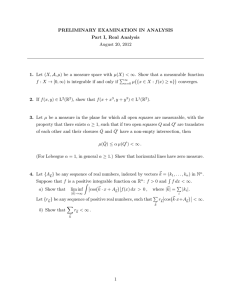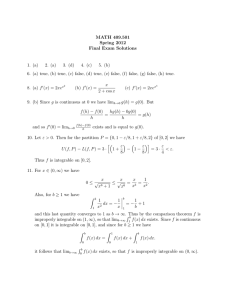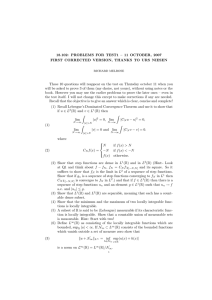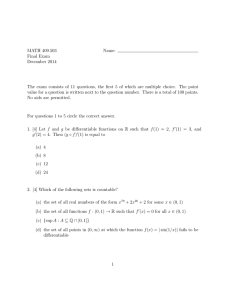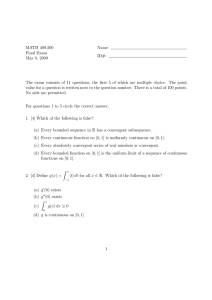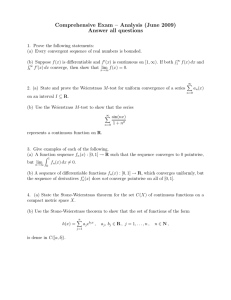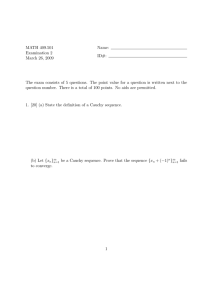MATH 409.200 Name: Final Exam ID#:
advertisement
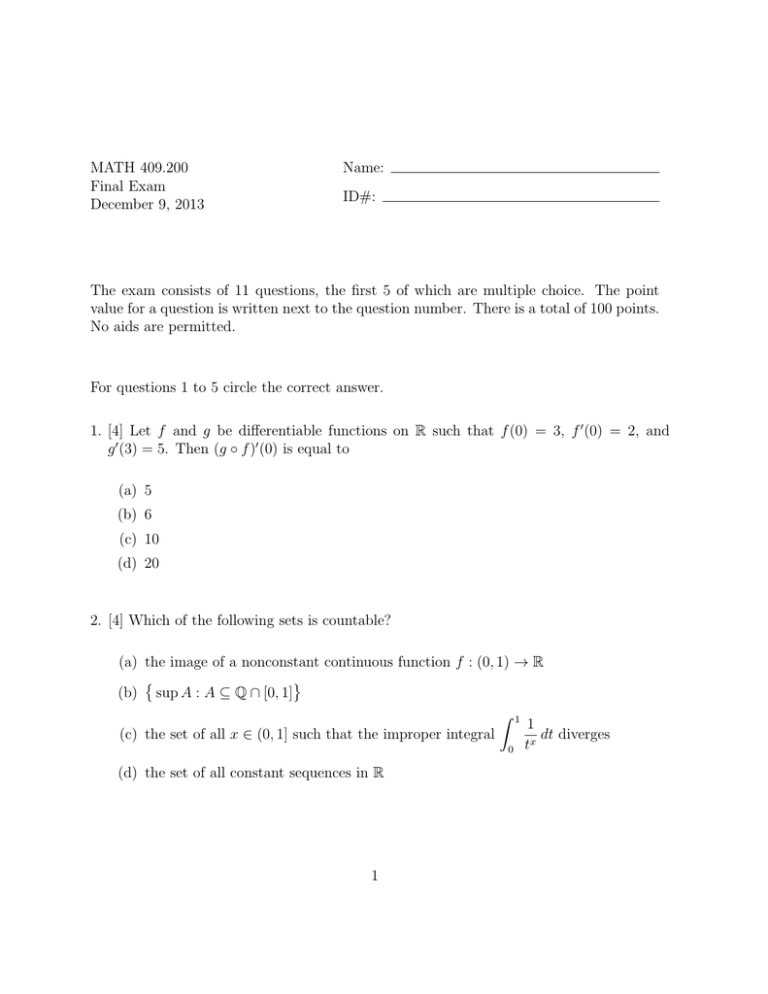
MATH 409.200
Final Exam
December 9, 2013
Name:
ID#:
The exam consists of 11 questions, the first 5 of which are multiple choice. The point
value for a question is written next to the question number. There is a total of 100 points.
No aids are permitted.
For questions 1 to 5 circle the correct answer.
1. [4] Let f and g be differentiable functions on R such that f (0) = 3, f 0 (0) = 2, and
g 0 (3) = 5. Then (g ◦ f )0 (0) is equal to
(a) 5
(b) 6
(c) 10
(d) 20
2. [4] Which of the following sets is countable?
(a) the image of a nonconstant continuous function f : (0, 1) → R
(b) sup A : A ⊆ Q ∩ [0, 1]
Z 1
1
dt diverges
(c) the set of all x ∈ (0, 1] such that the improper integral
x
0 t
(d) the set of all constant sequences in R
1
ln(x3 + 2)
=
x→∞ ln(x2 + 1)
3. [4] lim
(a) 0
(b)
3
2
(c) 2
(d) ∞
4. [4] The interval of convergence of the power series
∞
X
(x − 1)k
k=1
(a) [0, 2]
(b) (0, 2)
(c) (0, 2]
(d) [0, 2)
5. [4] Which of the following series diverges?
∞
X
1
(a)
kk
k=1
(b)
∞
X
k=1
(c)
∞
X
210k
k=1
(d)
sin k
k 3/2 + cos k
∞
X
k=1
k!
s
k + k 1/2 + 1
k3 + 5
2
k2
is
6. [24] In each of the following 8 cases, indicate whether the given statement is true or
false. No justification is necessary.
(a) If {xn }∞
n=1 is a sequence in R and f : R → R is a bounded function then the
sequence {f (xn )}∞
n=1 has a convergent subsequence.
(b) Let f be a differentiable function which is improperly integrable on (0, ∞). Then
lim f 0 (x) = 0.
x→∞
(c) Let f : [0, ∞) → R be a continuous function such that limx→∞ f (x) = 0. Then f
has a maximum value on [0, ∞).
(d) The function f (x) =
ex
is integrable on [0, 1].
x+1
3
(e) The function
f (x) =
x2 cos(sin(cos(1/x))),
0,
x 6= 0
x=0
is differentiable at x = 0.
n sin n
= 0.
n→∞ e2n
(f) lim
Z
1
|f (x)| dx > 0.
(g) If f is a nonconstant integrable function on [0, 1] then
0
(h) Let {fn } be a sequence of functions
on [0, 1] such that |fn (x)| ≤ 1/n2 for all n ∈ N
P∞
and x ∈ [0, 1]. Then the series n=1 fn converges uniformly on [0, 1].
4
Z
3+sin x
cos t dt. Determine f 0 .
7. [12] (a) Define f : R → R by f (x) =
cos x
Z
(b) Evaluate the improper integral
0
∞
e−x
dx.
e−x + 3
5
8. [12] (a) State what it means for a function on R to be uniformly continuous.
(b) State the completeness axiom for the real numbers.
(c) State the Mean Value Theorem.
6
9. [12] (a) State what it means for a sequence {fn } of functions to converge uniformly on
a nonempty set A ⊆ R to a function f .
(b) Give an example of a sequence {fn }∞
n=1 of continuous functions on [0, 1] which
converges pointwise on [0, 1] to a function which is not continuous at the point 12 .
(c) Give an example of a sequence {fn }∞
n=1 of continuous functions on [0, 1] such that
(i) {fn }∞
n=1 converges pointwise on [0, 1], and
R1
(ii) the sequence { 0 fn (x) dx}∞
n=1 is bounded but does not converge.
7
10. [10] (a) Define what it means for a bounded function f on a closed interval [a, b] to be
integrable on [a, b].
(b) Define the function f : [−1, 1] → R by
1, −1 ≤ x ≤ 0
f (x) =
x, 0 < x ≤ 1.
Prove directly from the definition of integrability that f is integrable on [−1, 1].
8
11. [10] Let f be a locally integrable function on R such that f (x) converges to a real
number L as x → ∞. Prove that
Z
1 x
f (t) dt = L.
lim
x→∞ x 0
9
